Upstream-Downstream Influence of Water Harvesting Techniques (Jessour) on Soil Water Retention in Southeast Tunisia
Abstract
1. Introduction
Study Area
2. Materials and Methods
2.1. Description of the Jessour System
2.2. Instrumented Sites
2.3. Experimental Setup
2.4. Calculation of Soil Water Content Values
2.5. Recharge, Drying and Activation of the Jesr
2.6. Calculation of Potential Evapotranspiration
3. Results
3.1. Characteristics of Soil Layers
3.2. Hydro-Meteorological Characteristics of the Four Observed Agricultural Years
3.3. Soil Moisture Dynamics in Upstream and Downstream Jessour
3.4. Capacity of Upstream and Downstream Jessour to Retain Available Water Content
3.5. Agricultural Year 2018–19
3.6. Agricultural Year 2019–20
3.7. Agricultural Year 2020–21
3.8. Agricultural Year 2021–22
3.9. Activation and Recharge of the Jessour According to Rainfall Typology
3.10. Comparison with the Site of Zammour
4. Discussion
4.1. Similarities and Differences between the Upstream and Downstream Jessour
4.2. Comparison with Similar Water Harvesting Techniques
4.3. Dynamics of Available Water Content and Olive Tree Vegetative Cycle
5. Conclusions
Author Contributions
Funding
Data Availability Statement
Acknowledgments
Conflicts of Interest
References
- Mwenge Kahinda, J.; Taigbenu, A.E. Rainwater Harvesting in South Africa: Challenges and Opportunities. Phys. Chem. Earth Parts A/B/C 2011, 36, 968–976. [Google Scholar] [CrossRef]
- Bonvallot, J. Comportement Des Ouvrages de Petite Hydraulique Dans La Région de Médenine (Tunisie Du Sud) Au Cours Des Pluies Exceptionnelles de Mars 1979. Cah. ORSTOM Sci. Hum. 1979, 16, 233–249. [Google Scholar]
- Abdelli, F.; Ouessar, M.; Khatteli, H. Méthodologie d’identification Des Ouvrages Existants et Des Sites Potentiels Pour Les Jessour. Rev. Des Sci. De L’eau/J. Water Sci. 2012, 25, 237–254. [Google Scholar] [CrossRef]
- Al-Seekh, S.H.; Mohammad, A.G. The Effect of Water Harvesting Techniques on Runoff, Sedimentation, and Soil Properties. Environ. Manag. 2009, 44, 37–45. [Google Scholar] [CrossRef]
- Ben Fraj, T.; Abderrahmen, A.; Ben Ouezdou, H.; Reynard, E.; Milano, M.; Calianno, M.; Fallot, J.-M. Les Jessour Dans Le Sud-Est Tunisien: Un Système Hydro-Agricole Ancestral Dans Un Milieu Aride. In Proceedings of the Actes du 29ème Colloque de l’Association Internationale de Climatologie (AIC), Lausanne, Switzerland, 6–9 September 2016; pp. 193–198. [Google Scholar]
- Gasmi, I.; Eslamian, S.; Moussa, M. Evaluation of Traditional Rainwater Harvesting Technique of “Jessour” in Southern Tunisia, a Case Study on El-Jouabit Catchment. In Handbook of Water Harvesting and Conservation; Eslamian, S., Eslamian, F., Eds.; John Wiley & Sons, Ltd: Chichester, UK, 2021; pp. 199–212. ISBN 978-1-119-77601-7. [Google Scholar]
- Abderrahmen, A. Les Intensités Des Pluies Dans La Tunisie Orientale. Ph.D. Thesis, Faculté des Sciences Humaines et Sociales de Tunis, Tunis, Tunisia, 2009. [Google Scholar]
- Bresci, E.; Castelli, G. Water Harvesting in Farmlands. In Handbook of Water Harvesting and Conservation; Eslamian, S., Ed.; Wiley: New York, NY, USA, 2021; pp. 87–100. ISBN 978-1-119-47891-1. [Google Scholar]
- Piras, F.; Zanzana, A.; Costa Pinto, L.M.; Fiore, B.; Venturi, M. The Role of the Jessour System for Agrobiodiversity Preservation in Southern Tunisia. Biodivers. Conserv. 2021, 31, 2479–2494. [Google Scholar] [CrossRef]
- Abdelli, F.; Ouessar, M.; M’Hemdi, S.; Guied, M.; Khatteli, H. Monitoring Soil Moisture Content of Jessour in the Watershed of Wadi Jir (Matmata, Southeast Tunisia). In Water and Land Security in Drylands; Ouessar, M., Gabriels, D., Tsunekawa, A., Evett, S., Eds.; Springer International Publishing: Cham, Switzerland, 2017; pp. 97–110. ISBN 978-3-319-54020-7. [Google Scholar]
- Calianno, M.; Fallot, J.-M.; Ben Fraj, T.; Ben Ouezdou, H.; Reynard, E.; Milano, M.; Abbassi, M.; Ghram Messedi, A.; Adatte, T. Benefits of Water-Harvesting Systems (Jessour) on Soil Water Retention in Southeast Tunisia. Water 2020, 12, 295. [Google Scholar] [CrossRef]
- Ouessar, M.; Bruggeman, A.; Abdelli, F.; Mohtar, R.H.; Gabriels, D.; Cornelis, W.M. Modelling Water-Harvesting Systems in the Arid South of Tunisia Using SWAT. Hydrol. Earth Syst. Sci. 2009, 13, 2003–2021. [Google Scholar] [CrossRef]
- Jothiprakash, V.; Sathe, M.V. Evaluation of Rainwater Harvesting Methods and Structures Using Analytical Hierarchy Process for a Large Scale Industrial Area. J. Water Resour. Prot. 2009, 1, 427–438. [Google Scholar] [CrossRef]
- Adham, A.; Riksen, M.; Ouessar, M.; Ritsema, C. A Methodology to Assess and Evaluate Rainwater Harvesting Techniques in (Semi-) Arid Regions. Water 2016, 8, 198. [Google Scholar] [CrossRef]
- Grum, B.; Woldearegay, K.; Hessel, R.; Baartman, J.E.M.; Abdulkadir, M.; Yazew, E.; Kessler, A.; Ritsema, C.J.; Geissen, V. Assessing the Effect of Water Harvesting Techniques on Event-Based Hydrological Responses and Sediment Yield at a Catchment Scale in Northern Ethiopia Using the Limburg Soil Erosion Model (LISEM). CATENA 2017, 159, 20–34. [Google Scholar] [CrossRef]
- Carletti, A.; Canu, S.; Motroni, A.; Ghiglieri, G. A Combined Methodology for Estimating the Potential Natural Aquifer Recharge in an Arid Environment. Hydrol. Sci. J. 2019, 64, 1727–1745. [Google Scholar] [CrossRef]
- Fleskens, L.; Stroosnijder, L.; Ouessar, M.; De Graaff, J. Evaluation of the On-Site Impact of Water Harvesting in Southern Tunisia. J. Arid. Environ. 2005, 62, 613–630. [Google Scholar] [CrossRef]
- Tadros, M.J.; Al-Mefleh, N.K.; Othman, Y.A.; Al-Assaf, A. Water Harvesting Techniques for Improving Soil Water Content, and Morpho-Physiology of Pistachio Trees under Rainfed Conditions. Agric. Water Manage. 2021, 243, 106464. [Google Scholar] [CrossRef]
- Saeed, A.B.; Hamid, A.M.N.; Abdalhi, M.A.M.; Mohamed, A.A. Evaluation the Effects of Water Harvesting Techniques in Improving Water Conservation and Increasing Crop Yields. Int. J. Sci. Eng. Investig. 2019, 8, 9. [Google Scholar]
- Mesfin, S.; Almeida Oliveira, L.A.; Yazew, E.; Bresci, E.; Castelli, G. Spatial Variability of Soil Moisture in Newly Implemented Agricultural Bench Terraces in the Ethiopian Plateau. Water 2019, 11, 2134. [Google Scholar] [CrossRef]
- Schiettecatte, W.; Ouessar, M.; Gabriels, D.; Tanghe, S.; Heirman, S.; Abdelli, F. Impact of Water Harvesting Techniques on Soil and Water Conservation: A Case Study on a Micro Catchment in Southeastern Tunisia. J. Arid. Environ. 2005, 61, 297–313. [Google Scholar] [CrossRef]
- Castelli, G.; Oliveira, L.A.A.; Abdelli, F.; Dhaou, H.; Bresci, E.; Ouessar, M. Effect of Traditional Check Dams (Jessour) on Soil and Olive Trees Water Status in Tunisia. Sci. Total Environ. 2019, 690, 226–236. [Google Scholar] [CrossRef]
- Rockström, J.; Barron, J.; Fox, P. Rainwater Management for Increased Productivity among Small-Holder Farmers in Drought Prone Environments. Phys. Chem. Earth Parts A/B/C 2002, 27, 949–959. [Google Scholar] [CrossRef]
- Dile, Y.T.; Karlberg, L.; Daggupati, P.; Srinivasan, R.; Wiberg, D.; Rockstroem, J. Assessing the Implications of Water Harvesting Intensification on Upstream-Downstream Ecosystem Services: A Case Study in the Lake Tana Basin. Sci. Total Environ. 2016, 542, 22–35. [Google Scholar] [CrossRef]
- Castelli, G.; Minelli, A.; Meron, T.; Bresci, E.; Yazew, E.; Gebreegziabher, T.; Sebhatleab, M. Impacts of Rainwater Harvesting and Rainwater Management on Upstream Downstream Agricultural Ecosystem Services in Two Catchments of Southern Tigray, Ethiopia. Chem. Eng. Trans. 2017, 58, 685–690. [Google Scholar] [CrossRef]
- Regaya, K. Etude Géologique de La Formation Des Limons de Matmata (Sud Tunisien). In Revue des Sciences de la Terre; INRST: Tunis, Tunisia, 1985; Volume 1. [Google Scholar]
- Coudé-Gaussen, G. Les Poussières Sahariennes et Leur Contribution Aux Sédimentations Désertiques et Péridésertiques. Ph.D. Thesis, Université Pierre et Marie Curie Paris 6, Paris, France, 1989. [Google Scholar]
- Ben Fraj, T. La Jeffara Septentrionale: Étude de l’Évolution Géomorphologique Au Cours Du Quaternaire. Ph.D. Thesis, Faculté des Sciences Humaines et Sociales de Tunis, Tunis, Tunisia, 2012. [Google Scholar]
- Ben Fraj, T. Proposition d’un Schéma Chronostratigraphique Des Héritages Quaternaires Continentaux de La Jeffara Septentrionale et de La Partie Nord-Orientale Du Plateau de Dahar-Matmata (Sud-Est Tunisien). Quaternaire 2012, 23, 187–204. [Google Scholar] [CrossRef]
- Bonvallot, J. Tabias et Jessour Du Sud Tunisien: Agriculture Dans Les Zones Marginales et Parade à l’érosion. Cah. ORSTOM Ser. Pedol. 1986, 22, 163–171. [Google Scholar]
- Floret, C.; Pontanier, R. L’aridité En Tunisie Présaharienne: Climat, Sol, Végétation et Aménagement; ORSTOM: Paris, France, 1982. [Google Scholar]
- Henia, L. Climat et Bilans de l’eau En Tunisie, Essai de Régionalisation Climatique Par Les Bilans Hydriques; Publication de l’Université de Tunis: Tunis, Tunisia, 1993. [Google Scholar]
- Institut National de la Météorologie. Fiche Climatique de La Station de Beni Khedache 1990–2004; Institut National de la Météorologie: Tunis, Tunisia, 2005. [Google Scholar]
- Ben Ouezdou, H. Les Aménagements de Petite Hydraulique Dans Le Sud Tunisien, Un Savoir-Faire Traditionnel Au Service Du Développement Durable. In Actes du Séminaire International «Patrimoine et Développement Durable en Méditerranée Occidentale»; Institut National du Patrimoine: Tunis, Tunisia, 2002; pp. 45–54. [Google Scholar]
- Bonvallot, J. Plaidoyer Pour Les Jessour. In L’aridité: Une Contrainte au Développement. Caractérisation, Réponses Biologiques, Stratégies des Sociétés; Le Floc’h, E., Grouzis, M., Cornet, A., Bille, J.-C., Eds.; Didactiques: Paris, France, 1992; pp. 507–517. [Google Scholar]
- Ben Ouezdou, H.; Trousset, P. Aménagements Hydrauliques Dans Le Sud-Est Tunisien. In Contrôle et Distribution de L’eau dans le Maghreb Antique et Médiéval; Ecole Française de Rome: Rome, Italy, 2009; pp. 1–18. [Google Scholar]
- Ouessar, M. Hydrological Impacts of Rainwater Harvesting in Wadi Oum Zessar Watershed (Southern Tunisia). Ph.D. Thesis, Ghent University, Ghent, Belgium, 2007. [Google Scholar]
- FAO. FAO World Reference Base for Soil Resources 2014: International Soil Classification System for Naming Soils and Creating Legends for Soil Maps; World Soil Resources Reports; FAO: Rome, Italy, 2014. [Google Scholar]
- Dean, T.J.; Bell, J.P.; Baty, A.J.B. Soil Moisture Measurement by an Improved Capacitance Technique, Part I. Sensor Design and Performance. J. Hydrol. 1987, 93, 67–78. [Google Scholar] [CrossRef]
- Espitalie, J.; Deroo, G.; Marquis, F. Rock-Eval Pyrolysis and Its Applications (Part 2). Rev. De L’institut Français Du Pétrole 1985, 40, 755–784. [Google Scholar] [CrossRef]
- Rawls, W.J.; Brakensiek, D.L.; Saxton, K.E. Estimating Soil Water Retention from Soil Properties. J. Irrig. Drain. Eng. 1982, 108, 166–171. [Google Scholar] [CrossRef]
- Richards, L.A.; Weaver, L.R. Moisture Retention by Some Irrigated Soils as Related to Soil Moisture Tension. J. Agric. Res. 1944, 69, 215–235. [Google Scholar]
- Gupta, S.C.; Larson, W.E. Estimating Soil Water Retention Characteristics from Particle Size Distribution, Organic Matter Percent, and Bulk Density. Water Resour. Res. 1979, 15, 1633–1635. [Google Scholar] [CrossRef]
- Turc, L. Estimation of Irrigation Water Requirements, Potential Evapotranspiration: A Simple Climatic Formula Evolved up to Date. Ann. Agron. 1961, 12, 13–49. [Google Scholar]
- Damagnez, J.; Riou, C.; De Villele, O.; El Amami, S. Estimation et Mesure de l’évapotranspiration Potentielle En Tunisie. A.I.H.S. 1963, 62, 98–119. [Google Scholar]
- Clapp, R.B.; Hornberger, G.M. Empirical Equations for Some Soil Hydraulic Properties. Water Resour. Res. 1978, 14, 601–604. [Google Scholar] [CrossRef]
- Šimanský, V.; Juriga, M.; Jonczak, J.; Uzarowicz, Ł.; Stępień, W. How Relationships between Soil Organic Matter Parameters and Soil Structure Characteristics Are Affected by the Long-Term Fertilization of a Sandy Soil. Geoderma 2019, 342, 75–84. [Google Scholar] [CrossRef]
- Gruhier, C.; de Rosnay, P.; Hasenauer, S.; Holmes, T.; de Jeu, R.; Kerr, Y.; Mougin, E.; Njoku, E.; Timouk, F.; Wagner, W.; et al. Soil Moisture Active and Passive Microwave Products: Intercomparison and Evaluation over a Sahelian Site. Hydrol. Earth Syst. Sci. 2010, 14, 141–156. [Google Scholar] [CrossRef]
- Milly, P.C.D. Potential Evaporation and Soil Moisture in General Circulation Models. J. Clim. 1992, 5, 209–226. [Google Scholar] [CrossRef]
- Lü, H.; Zhu, Y.; Skaggs, T.H.; Yu, Z. Comparison of Measured and Simulated Water Storage in Dryland Terraces of the Loess Plateau, China. Agric. Water Manag. 2009, 96, 299–306. [Google Scholar] [CrossRef]
- Xu, Y.; Zhu, G.; Wan, Q.; Yong, L.; Ma, H.; Sun, Z.; Zhang, Z.; Qiu, D. Effect of Terrace Construction on Soil Moisture in Rain-Fed Farming Area of Loess Plateau. J. Hydrol. Reg. Stud. 2021, 37, 100889. [Google Scholar] [CrossRef]
- Yang, L.; Wei, W.; Chen, L.; Chen, W.; Wang, J. Response of Temporal Variation of Soil Moisture to Vegetation Restoration in Semi-Arid Loess Plateau, China. CATENA 2014, 115, 123–133. [Google Scholar] [CrossRef]
- Gómez, J.A.; Llewellyn, C.; Basch, G.; Sutton, P.B.; Dyson, J.S.; Jones, C.A. The Effects of Cover Crops and Conventional Tillage on Soil and Runoff Loss in Vineyards and Olive Groves in Several Mediterranean Countries. Soil Use Manag. 2011, 27, 502–514. [Google Scholar] [CrossRef]
- Coppola, A.; Abdallah, M.; Dragonetti, G.; Zdruli, P.; Lamaddalena, N. Monitoring and Modelling the Hydrological Behaviour of a Reclaimed Wadi Basin in Egypt. Ecohydrology 2019, 12, e2084. [Google Scholar] [CrossRef]
- Sanz-Cortés, F.; Martinez-Calvo, J.; Badenes, M.L.; Bleiholder, H.; Hack, H.; Llacer, G.; Meier, U. Phenological Growth Stages of Olive Trees (Olea Europaea). Ann. Appl. Biol. 2002, 140, 151–157. [Google Scholar] [CrossRef]
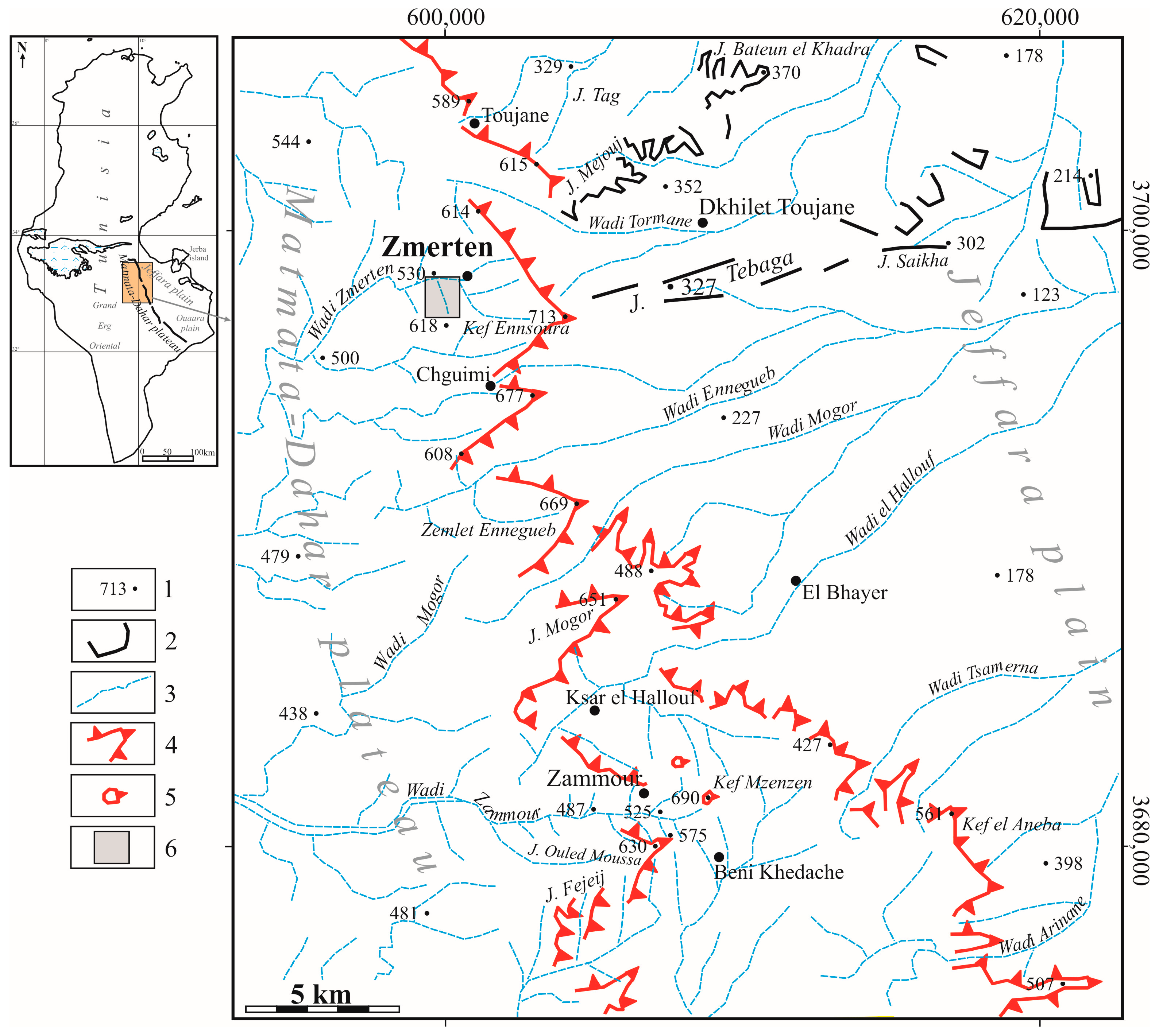
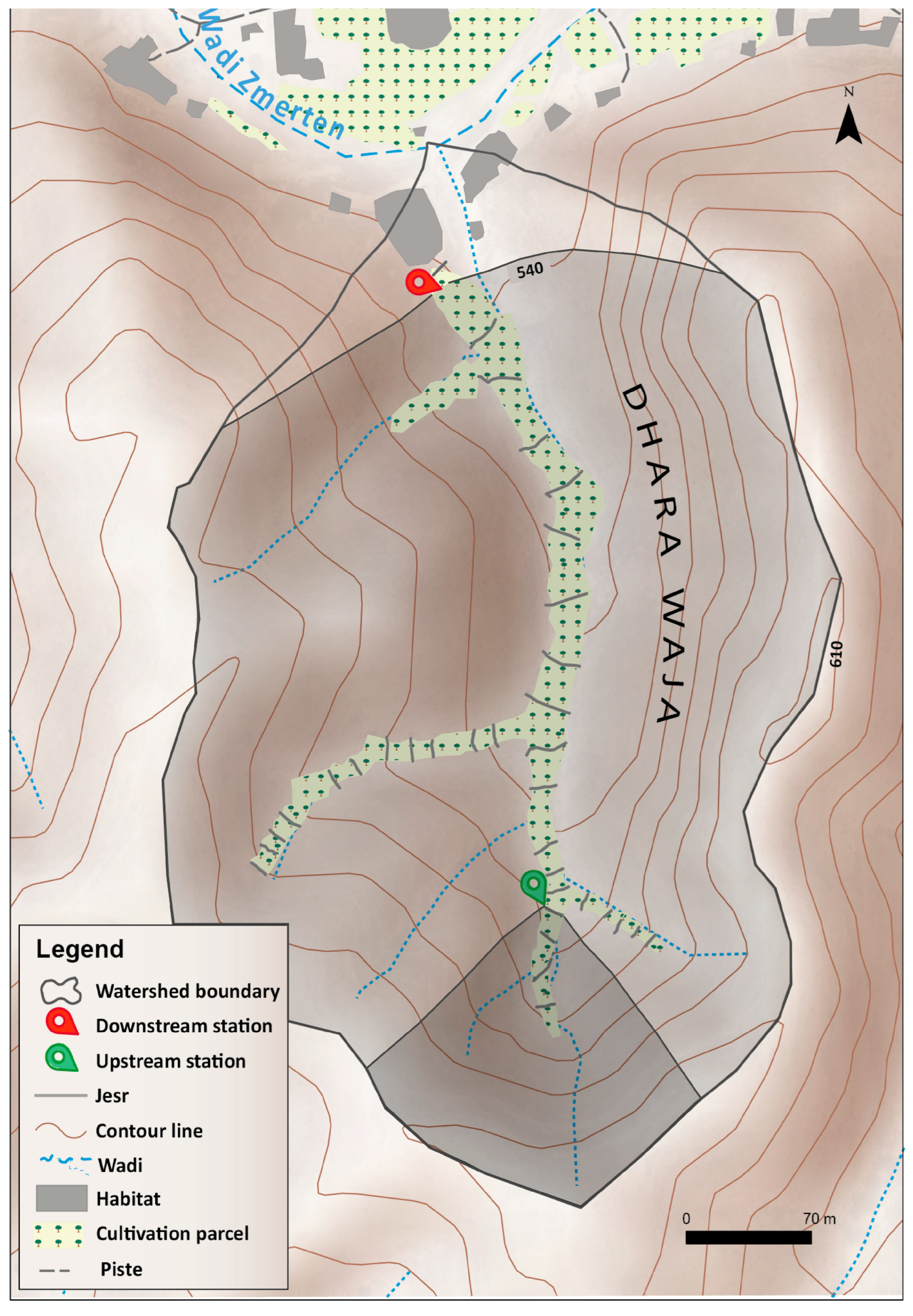
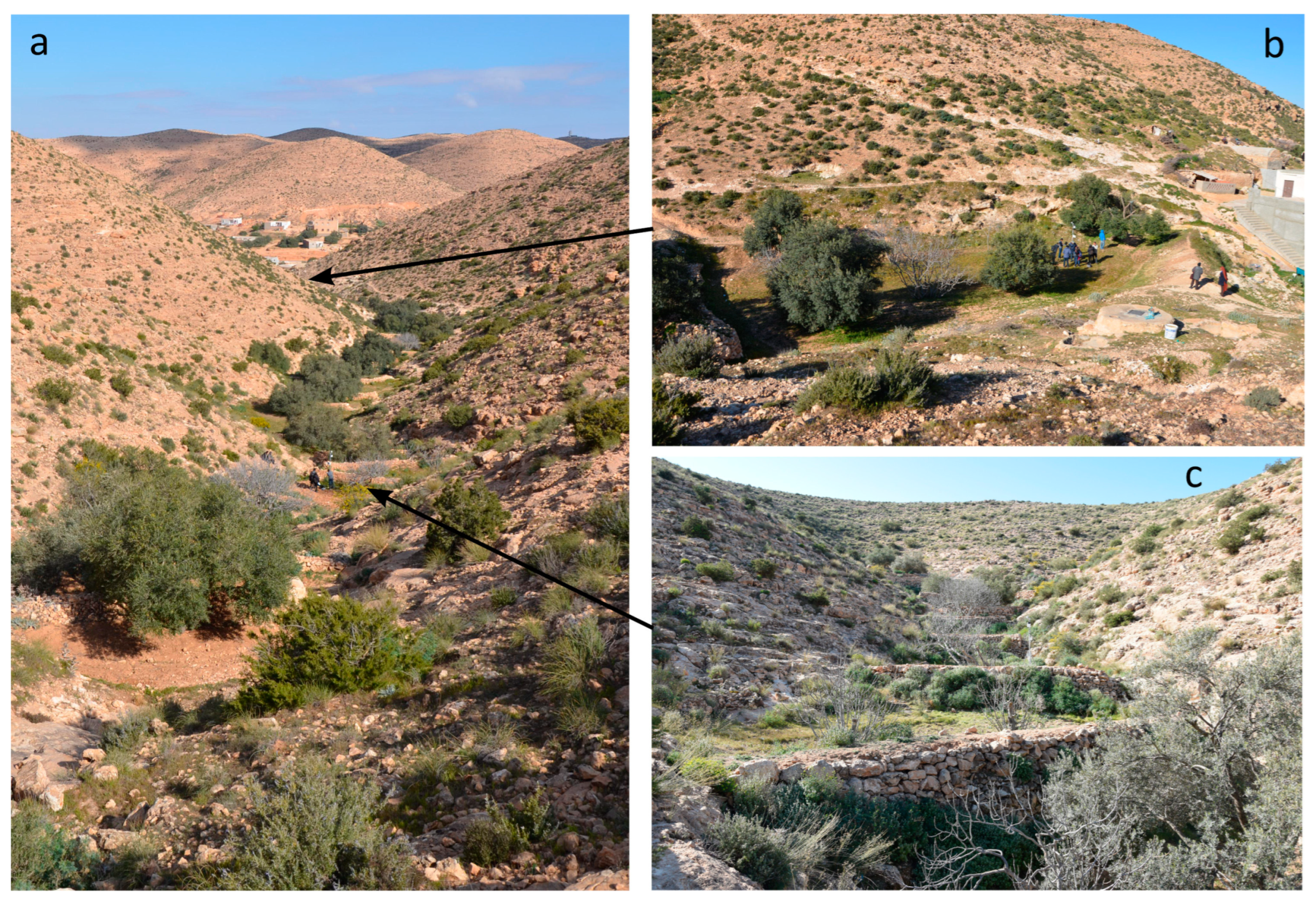
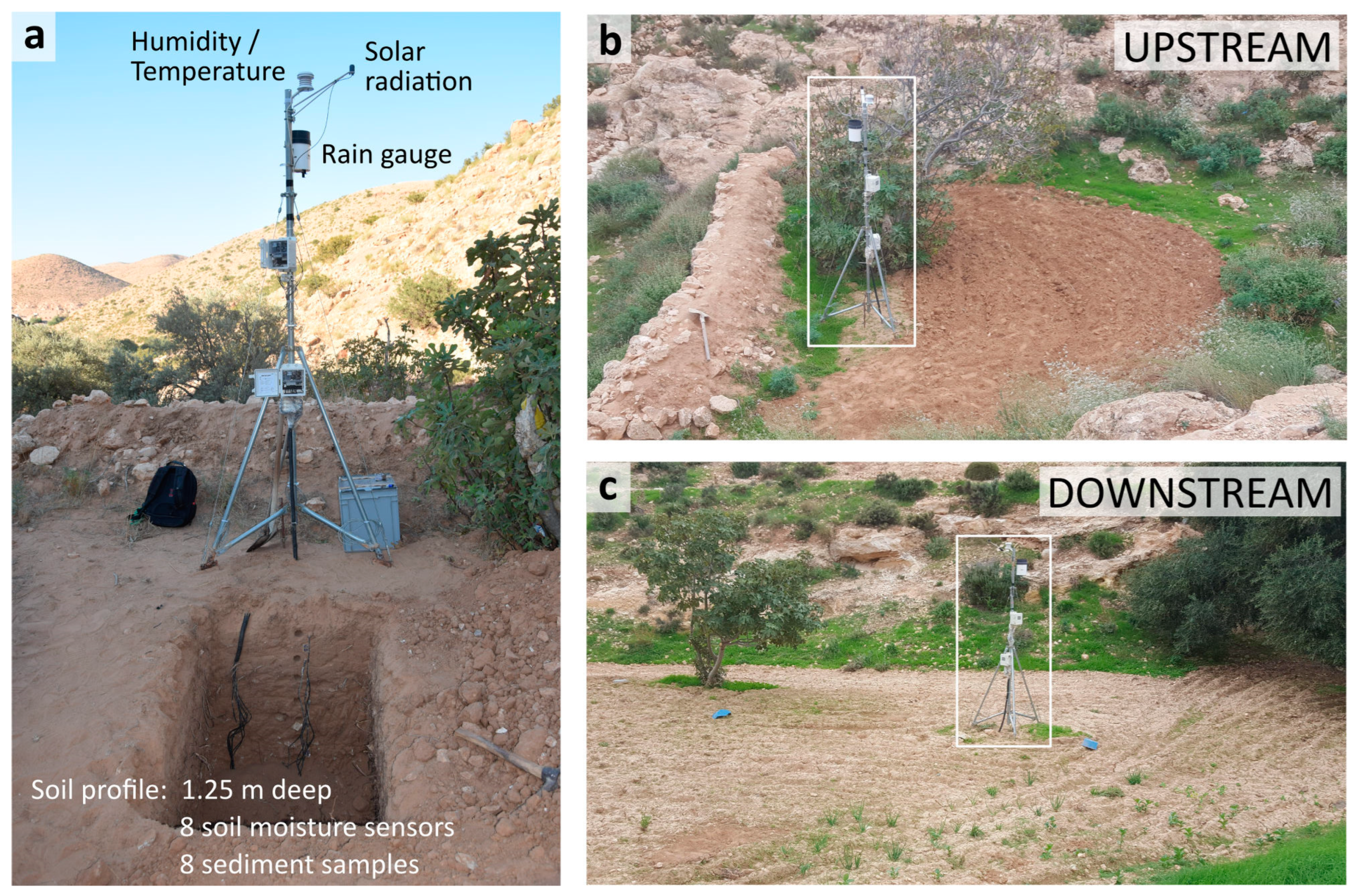
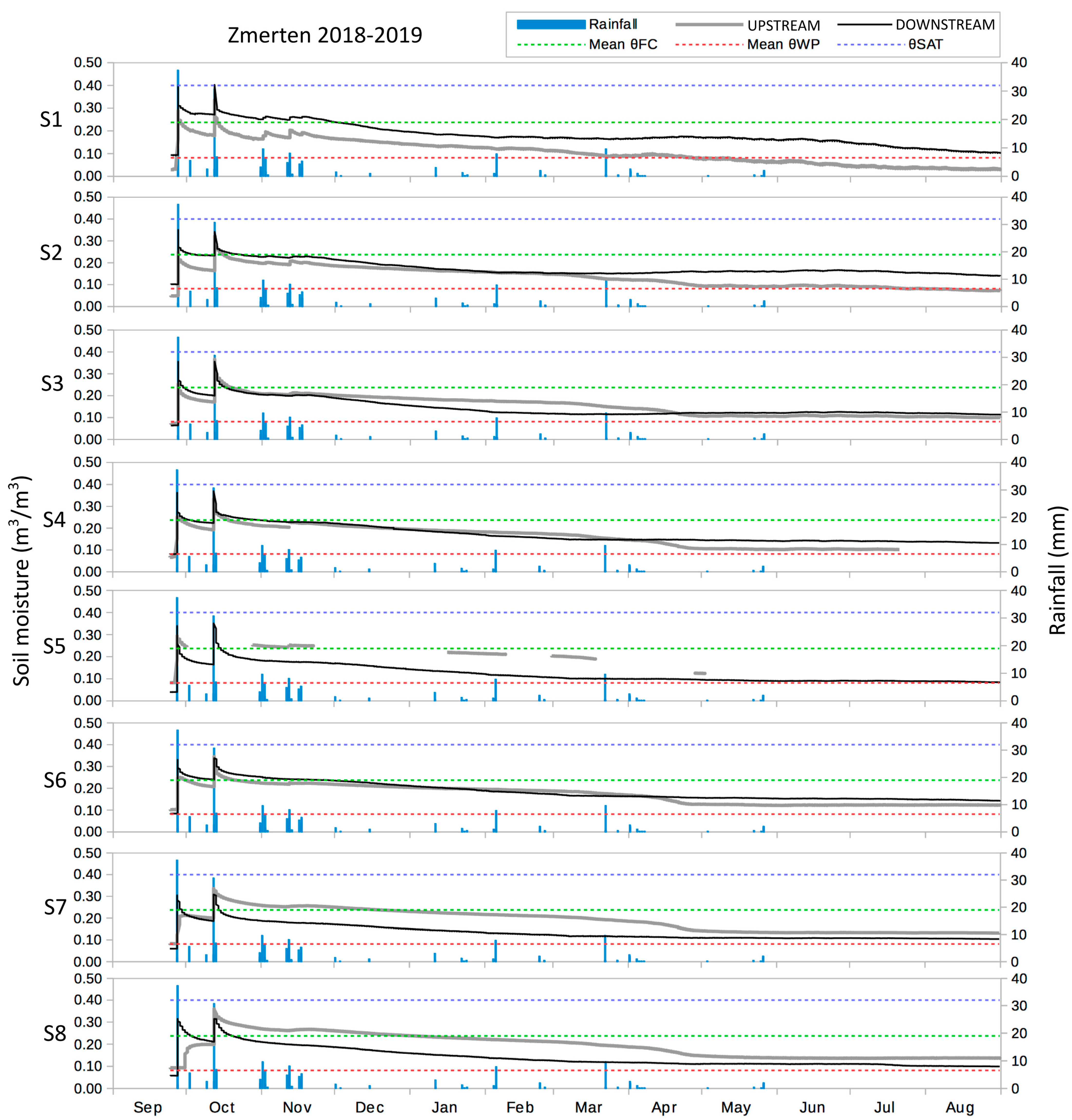
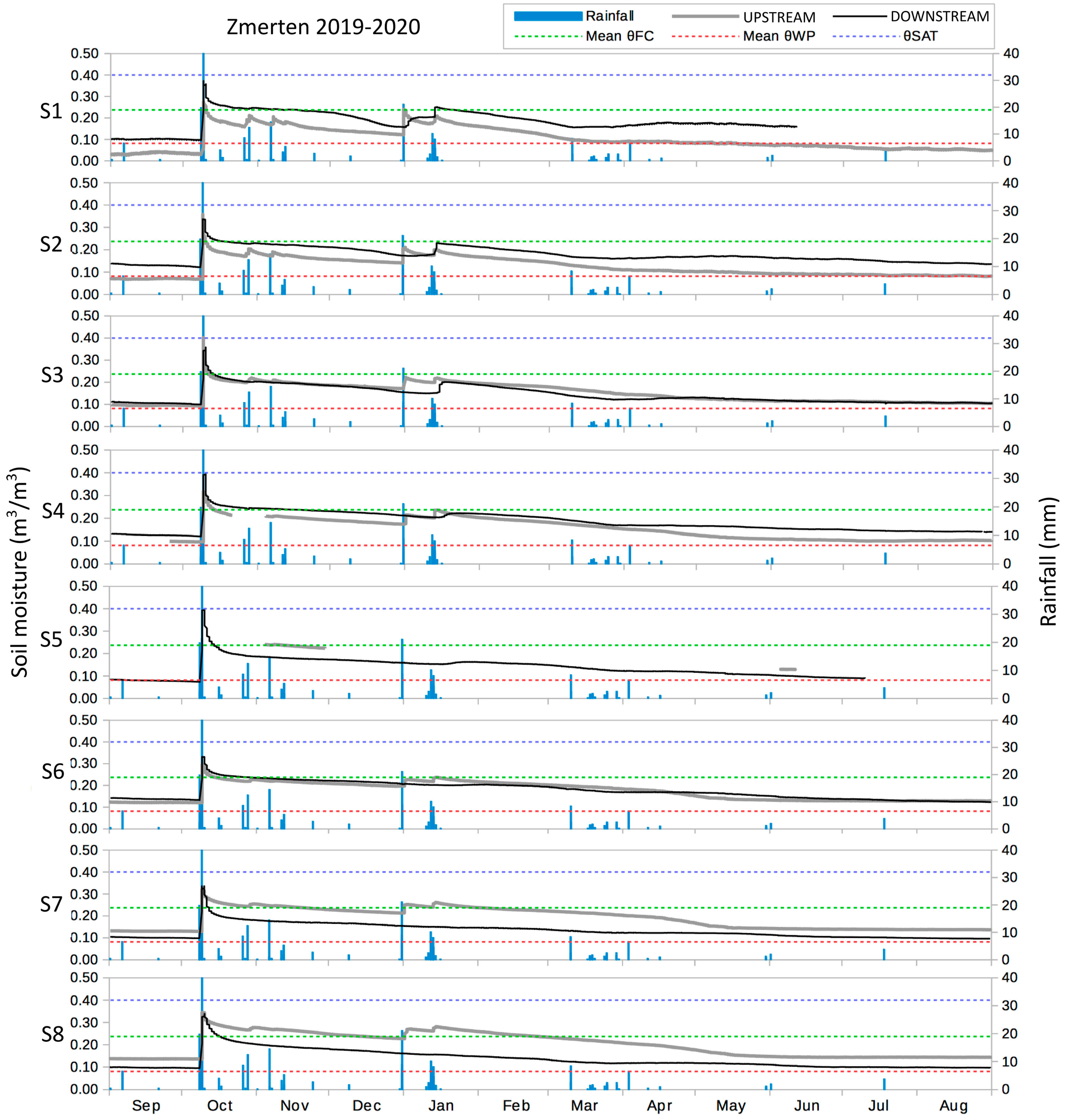
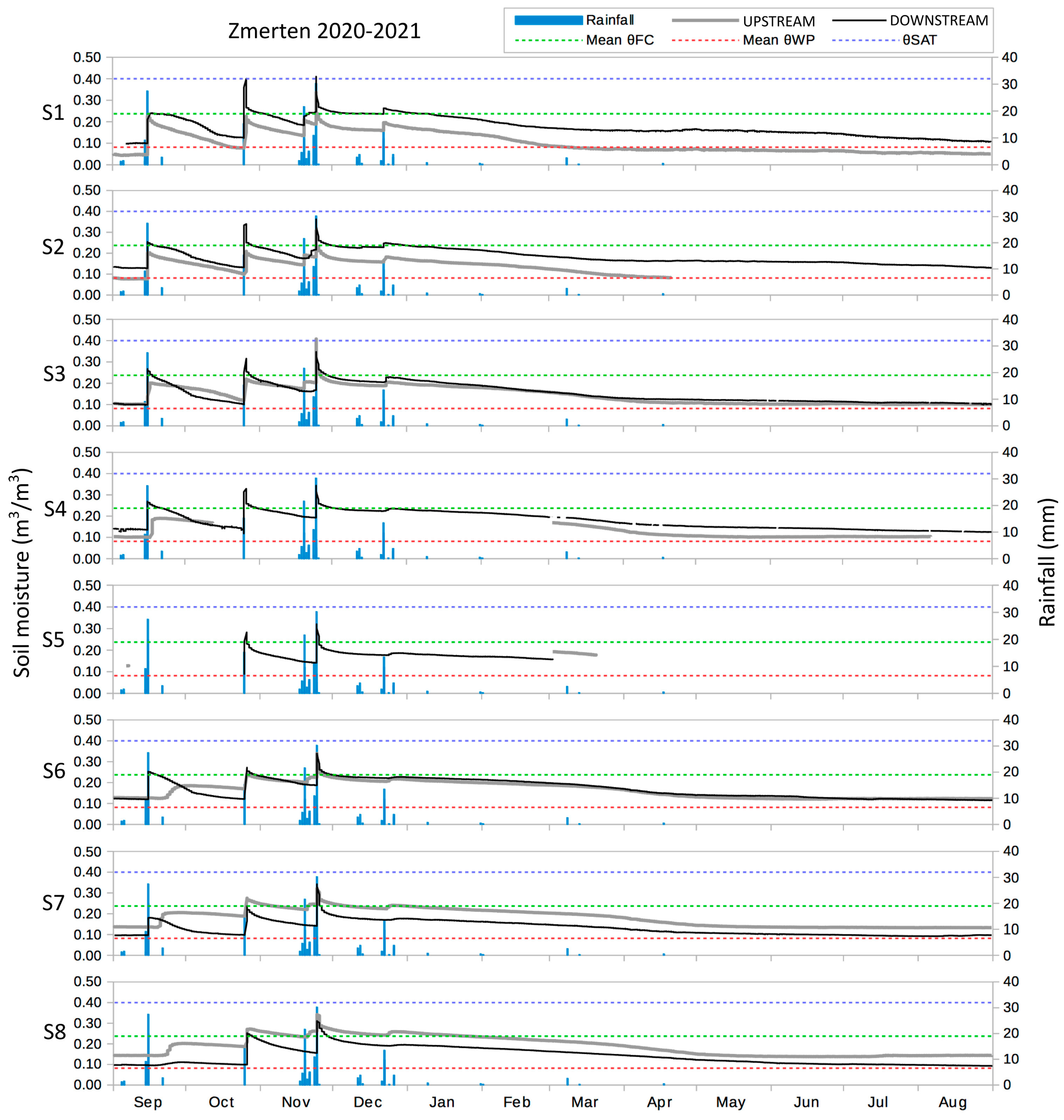
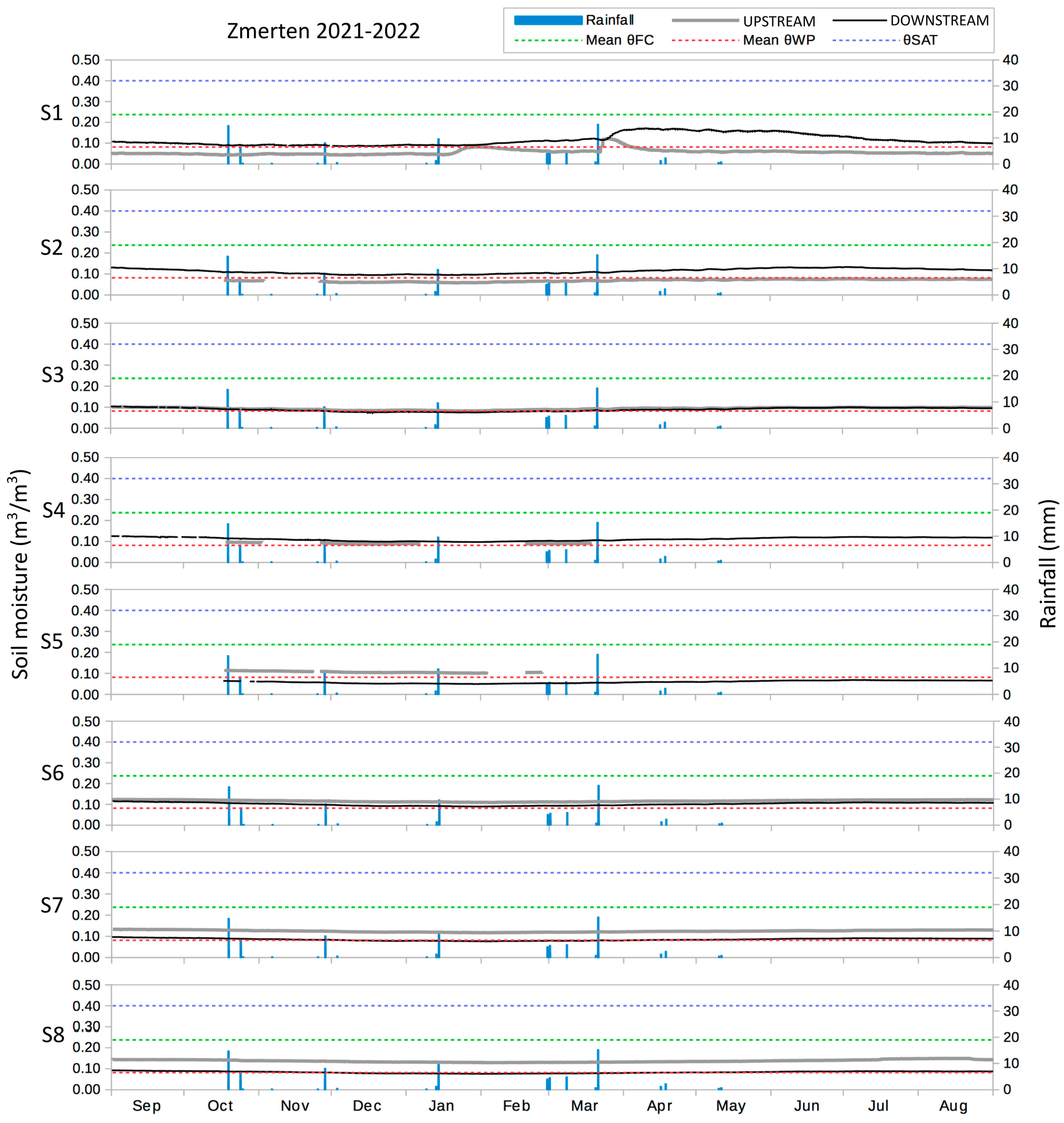
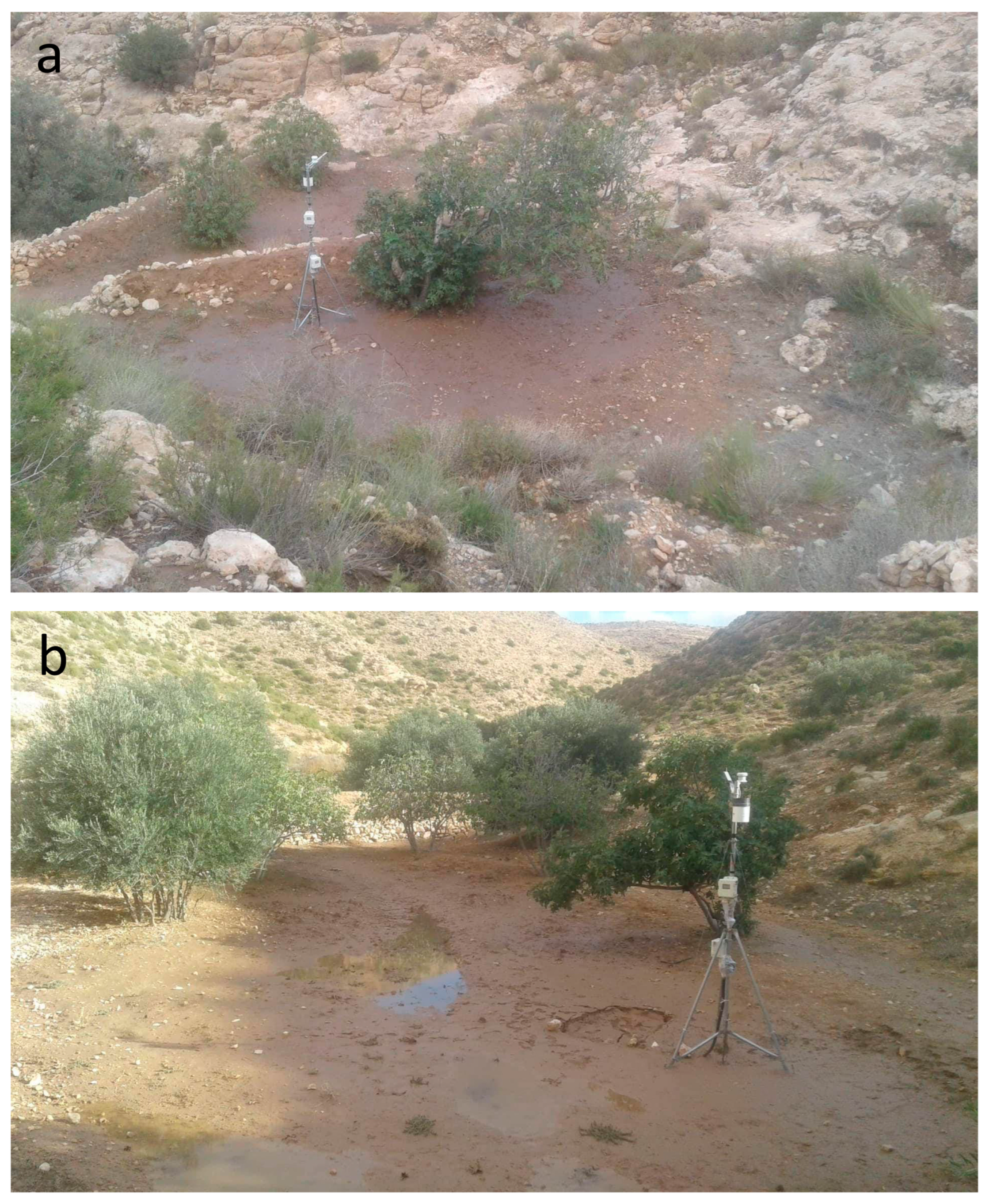
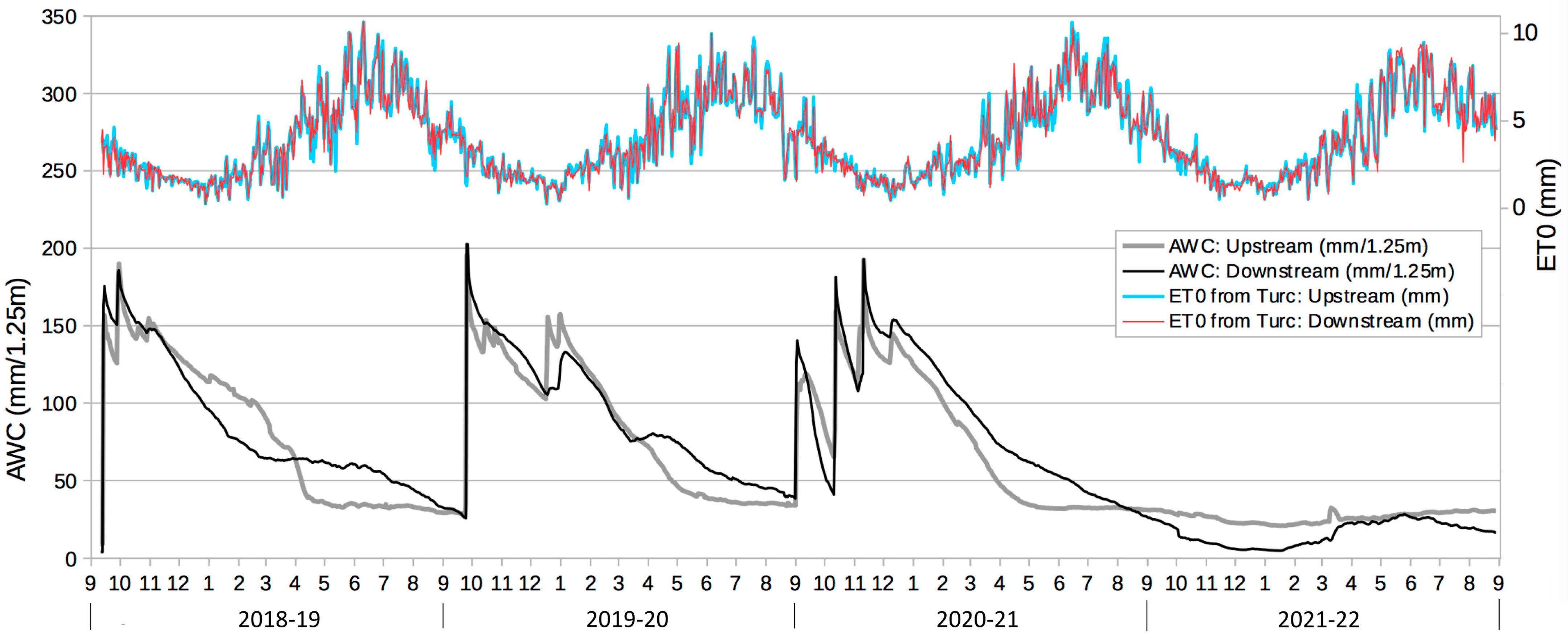
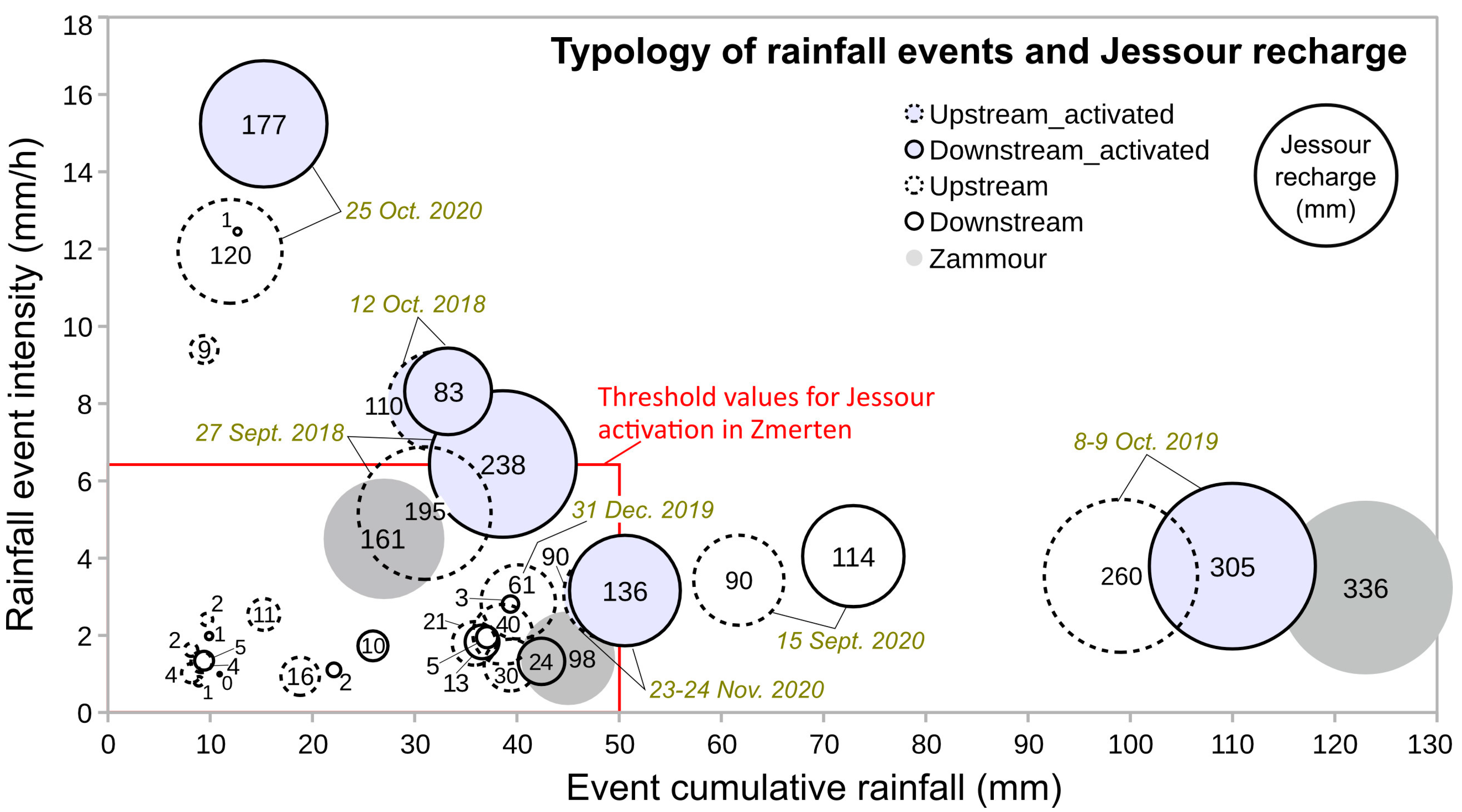
| Device | Measured Parameter | Unit | Time Step |
|---|---|---|---|
| Meteorological station | |||
| Pyranometer | Solar radiation | W/m2 | 1 measurement/1 h |
| Bucket rain gauge | Rainfall | mm | 1 measurement/1 h |
| Sheltered sensor | Temperature | °C | 1 measurement/1 h |
| Sheltered sensor | Relative humidity | % | 1 measurement/1 h |
| Soil station (8 sensors and 8 samples, every 15 cm) | |||
| ECH2O sensors: measurement based on the capacitance technique | Volumetric water content (θ) | m3/m3 (water vol./soil vol.) | 1 measurement/2 h |
| Soil samples (laser granulometry) | Soil texture | % Clay, % Silt, % Sand | |
| Soil samples (Rock-Eval pyrolysis) | Total organic carbon | % Organic Matter (% OM) | |
| Sensors | Soil Layer Thickness | Texture (WRB Class) | Clay (%) <0.002 mm | Silt (%) 0.002–0.063 mm | Sand (%) 0.063–2 mm | Organic Matter (%) | θFC (m3/m3) | θWP (m3/m3) |
|---|---|---|---|---|---|---|---|---|
| Upstream | ||||||||
| S1 (−20 cm) | 20 cm | Silt Loam | 10.3 | 67.3 | 22.4 | 0.67 | 0.27 | 0.09 |
| S2 (−35 cm) | 15 cm | Silt Loam | 10.5 | 65.6 | 23.8 | 0.54 | 0.26 | 0.09 |
| S3 (−50 cm) | 15 cm | Silt Loam | 9.5 | 68.2 | 22.3 | 0.68 | 0.27 | 0.08 |
| S4 (−65 cm) | 15 cm | Silt Loam | 12.2 | 63.8 | 24.0 | 0.38 | 0.26 | 0.09 |
| S5 (−80 cm) | 15 cm | Loam | 9.3 | 49.5 | 41.2 | 0.42 | 0.22 | 0.08 |
| S6 (−95 cm) | 15 cm | Sandy Loam | 6.1 | 39.2 | 54.7 | 0.49 | 0.18 | 0.06 |
| S7 (−110 cm) | 15 cm | Sandy Loam | 6.0 | 32.4 | 61.5 | 0.44 | 0.17 | 0.06 |
| S8 (−125 cm) | 15 cm | Silt Loam | 11.9 | 58.5 | 29.6 | 0.50 | 0.26 | 0.09 |
| Downstream | ||||||||
| S1 (−20 cm) | 20 cm | Silt Loam | 13.3 | 79.1 | 7.7 | 1.36 | 0.33 | 0.11 |
| S2 (−35 cm) | 15 cm | Silt Loam | 11.3 | 65.5 | 23.2 | 0.82 | 0.28 | 0.10 |
| S3 (−50 cm) | 15 cm | Silt Loam | 11.7 | 59.9 | 28.5 | 0.58 | 0.26 | 0.09 |
| S4 (−65 cm) | 15 cm | Silt Loam | 8.4 | 55.6 | 36.0 | 0.66 | 0.24 | 0.08 |
| S5 (−80 cm) | 15 cm | Sandy Loam | 3.9 | 25.4 | 70.7 | 0.32 | 0.14 | 0.05 |
| S6 (−95 cm) | 15 cm | Silt Loam | 12.3 | 71.4 | 16.3 | 0.59 | 0.29 | 0.10 |
| S7 (−110 cm) | 15 cm | Sandy Loam | 6.5 | 34.7 | 58.8 | 0.25 | 0.17 | 0.06 |
| S8 (−125 cm) | 15 cm | Loam | 7.8 | 42.2 | 50.1 | 0.10 | 0.19 | 0.07 |
| Agricultural Year (Sept-Aug) | 2018–19 Up/Down | 2019–20 Up/Down | 2020–21 Up/Down | 2021–22 Up/Down | Beni Khedache (1990–2004) |
|---|---|---|---|---|---|
| Rainfall (mm) | 176/195 | 303/318 | 235/260 | n.a./124 | 271 |
| Temperature (°C) | 18.1/17.8 | 19.2/18.9 | 19.8/19.6 | 19.4/19.1 | 20.1 |
| ET0 (mm) | 1332/1320 | 1458/1454 | 1473/1464 | 1457/1453 | |
| Recharge (mm) | 329/324 | 386/331 | 365/448 | 23/10 | |
| Drying (mm) | 303/283 | 375/319 | 371/476 | 9/5 | |
| Difference Recharge-Drying (mm) | 26/41 | 10/12 | −6/−27 | 14/5 |
| Date | Jesr | AWC (mm) Agricultural Year 2018–2019 | AWC (mm) Agricultural Year 2019–2020 | AWC (mm) Agricultural Year 2020–2021 | AWC (mm) Agricultural Year 2021–2022 |
|---|---|---|---|---|---|
| 20 February | Upstream | 103 | 115 | 93 | 22 |
| Downstream | 74 | 111 | 111 | 9 | |
| 15 June | Upstream | 35 | 38 | 32 | 28 |
| Downstream | 61 | 56 | 57 | 26 | |
| End of dry season | Upstream | 28 (7 October) | 33 (14 September) | 32 (1 October) | 29 (18 October) |
| Downstream | 26 (7 October) | 38 (14 September) | 25 (1 October) | 14 (18 October) |
Disclaimer/Publisher’s Note: The statements, opinions and data contained in all publications are solely those of the individual author(s) and contributor(s) and not of MDPI and/or the editor(s). MDPI and/or the editor(s) disclaim responsibility for any injury to people or property resulting from any ideas, methods, instructions or products referred to in the content. |
© 2023 by the authors. Licensee MDPI, Basel, Switzerland. This article is an open access article distributed under the terms and conditions of the Creative Commons Attribution (CC BY) license (https://creativecommons.org/licenses/by/4.0/).
Share and Cite
Calianno, M.; Ben Fraj, T.; Fallot, J.-M.; Abbassi, M.; Ghram Messedi, A.; Ben Ouezdou, H.; Reynard, E. Upstream-Downstream Influence of Water Harvesting Techniques (Jessour) on Soil Water Retention in Southeast Tunisia. Water 2023, 15, 1361. https://doi.org/10.3390/w15071361
Calianno M, Ben Fraj T, Fallot J-M, Abbassi M, Ghram Messedi A, Ben Ouezdou H, Reynard E. Upstream-Downstream Influence of Water Harvesting Techniques (Jessour) on Soil Water Retention in Southeast Tunisia. Water. 2023; 15(7):1361. https://doi.org/10.3390/w15071361
Chicago/Turabian StyleCalianno, Martin, Tarek Ben Fraj, Jean-Michel Fallot, Mohamed Abbassi, Aziza Ghram Messedi, Hédi Ben Ouezdou, and Emmanuel Reynard. 2023. "Upstream-Downstream Influence of Water Harvesting Techniques (Jessour) on Soil Water Retention in Southeast Tunisia" Water 15, no. 7: 1361. https://doi.org/10.3390/w15071361
APA StyleCalianno, M., Ben Fraj, T., Fallot, J.-M., Abbassi, M., Ghram Messedi, A., Ben Ouezdou, H., & Reynard, E. (2023). Upstream-Downstream Influence of Water Harvesting Techniques (Jessour) on Soil Water Retention in Southeast Tunisia. Water, 15(7), 1361. https://doi.org/10.3390/w15071361







